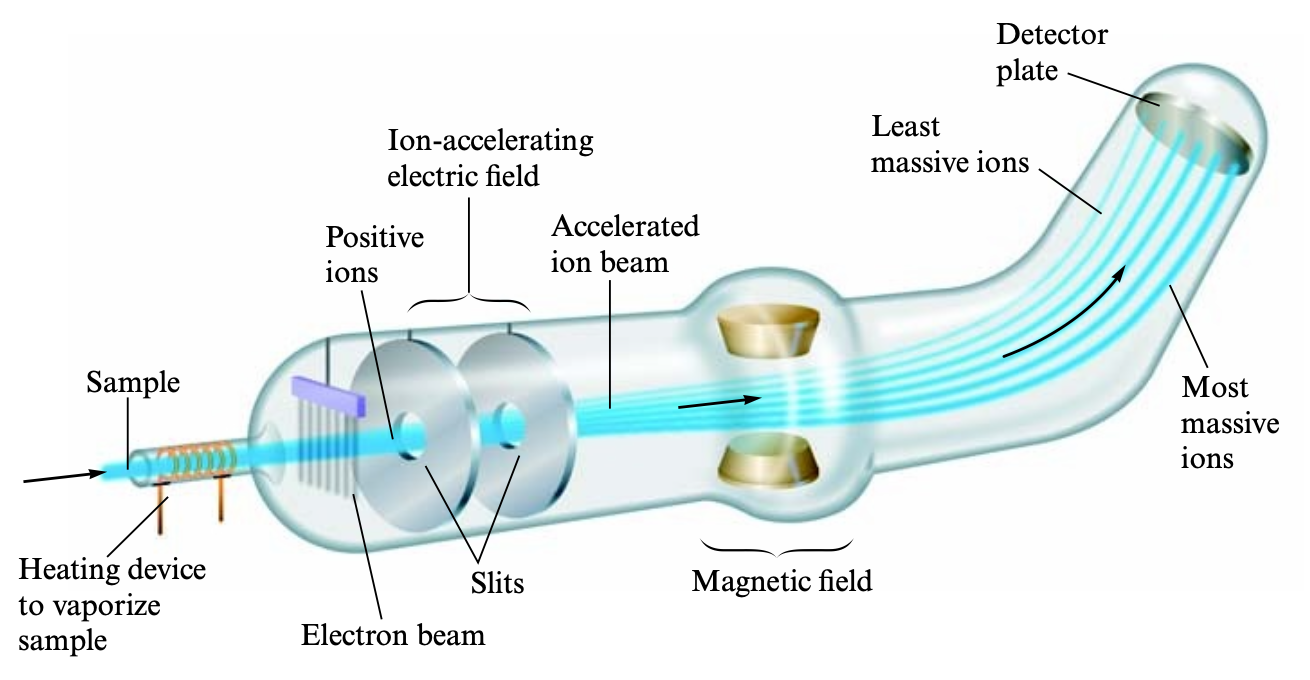Introduction to Stoichiometry
Chemical reactions are an essential part of our lives. As we analyze these reactions, we begin to see that the amounts of a molecule consumed or produced can be precisely calculated using mathematical principles. The only problem is that atoms are extremely tiny - we can't see them at all! So how do we count and measure them? This is where chemical stoichiometry comes into the picture. Stoichiometry is the study of the quantities of materials consumed and produced in chemical reactions.Atomic Masses and Stoichiometry
Just like grams or kilograms are used to measure items in the real world, atomic masses are ued to measure things on an atomic scale. To compare the masses of different atoms, scientists use a mass spectrometer. In a mass spectrometer, atoms and molecules are passed into a beam of high-speed electrons, which knock off the electrons from the atoms and molecules. Now positively charged ions, these atoms and molecules pass through an electric field, causing them to accelerate. The accelerating charged particles are then acted on by a magnetic field, causing them to curve different amounts based on their mass. After curving, the atoms and molecules collide with a detector plate. Based on the position at which they collided with the plate, the atoms' and molecules' weight can be compared. The atoms and molecules with the most mass are deflected the least and those with the least mass are deflected the least. Although this is not required, if you know electricity and magnetism in physics, the following formula for radius/curvature can be derived: $$ F_C=\frac{mv^2}{r}=qvB$$ $$r=\frac{mv}{qB}$$ So now we can see that the radius and mass are directly proportional, making larger masses curve more than smaller masses (as velocity \(v\) and magnetic field strength \(B\) are equal for each molecule and atom). We can even use this formula to determine the exact ratios of two masses.
The Mole
In real life, any quantity of a material is composed of a very, very, very large quantity of atoms. Instead of writing these very large numbers, scientists use an abbreviated unit called the mole, or mol for short. The value of 1 mole is equal to the number of carbon atoms in exactly 12 grams of pure carbon-12. This value is called Avogadro's number and is equal to \(6.02214 \times 10^{23}\). This is an extremely important value and must be memorized! Just like 1 dozen eggs is 12 eggs, 1 mole of atoms is \(6.02214 \times 10^{23}\) atoms. Just like other units, numbers of atoms can be converted to the mole unit. Additionally, the mass of 1 mole of any element is the same as the atom's atomic mass in grams.The molar mass of any chemical compound is the mass in grams of 1 mole of the compound. For example:$$\text{Molar mass of CH}_\text{4} = \text{Mass of 1 mole C} + \text{Mass of 4 mole H} = 12.01\text{g} + 4 \times 1.008 \text{g} = 16.04 \text{g}$$ Molecular weight and molar mass are used interchangeably to refer to this quantity.
Since ionic compounds do not contain molecules but instead polyatomic ions, one ionic compound is called a formula unit. For example, CaCO3 is the formula unit for calcium carbonate.
The mass percent for an atom in a molecule is the ratio of the mass of all atoms of that type in the molecule to the mass of the whole molecule.$$\text{Calculate the mass percent of carbon in C}_2\text{H}_5\text{OH.}$$ $$\frac{\text{Total mass of carbon}}{\text{Total mass of molecule}} = \frac{2\text{mol} \times 12.011 \frac{g}{mol}}{46.07g} \times 100\% = 52.14\% $$
Using Mass Percents to Determine Molecular Formula
After a new compound is discovered, scientists must determine its chemical formula. TO do this, they take a weighted sample of the compound and either decompose it into its separate elements or react it with oxygen to produce known substances like CO2, H2O, and N2. These elements or substances are then weighed and mass percents are used to determine the amount of each atom in the compound.
Chemical Reactions
The left part of a chemical equation is the reactants and the right side is the products. In a chemical reaction, no atoms must be created or destroyed. Therefore, the number of each atom on either side of the equation must be equal. The process of making the two sides of a chemical reaction have the same number of atoms on either side is called balancing the chemical equation. When doing this process, the formulas of the compounds must never be changed, only the number of multiples of the compound! The chemical reaction provides us with the nature of reactants and products as well as the number of each. In some cases, the reactions can also provide the state of the reaction by writing the symbols aq for aqueous, s for solid, l for liquid, and g for gas.In some cases, there is a limiting reactant in the chemical reaction. This is the reactant that is completely consumed in the reaction while some of the other reactants are left over. To determine the limiting reactant, simply divide the amount of the compound by the required number in the formula. The compound with the lowest number is the limiting reactant. When a reaction can proceed to completion without any reactants being left over, the mixture is called a stoichiometric mixture.
